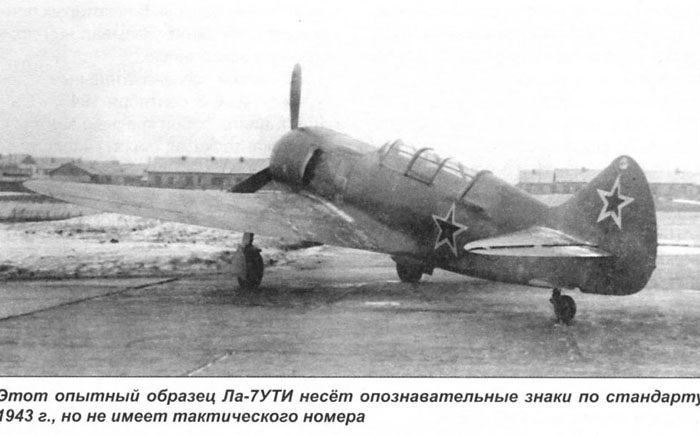
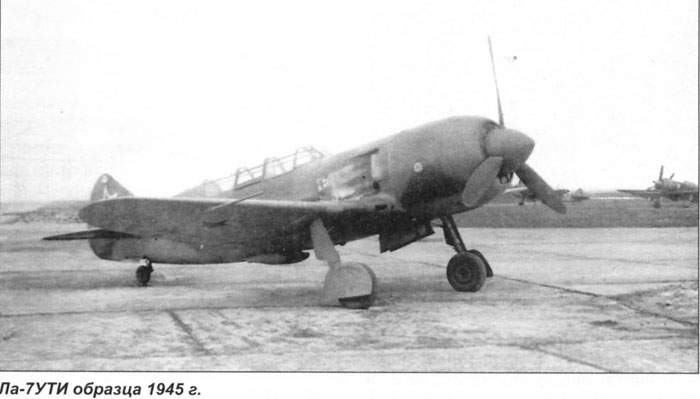
A trainer version of La-7 was needed.
In March 1945, Zavod 21 in Gorky started to convert production La-7 into the first prototype of La-7UTI.
In August, the plane was tested at the Research Institute of the Air Force (NII VVS).
Test were not favourable, showing a center of gravity too moved back (at 25% of Mean Aerodynamic chord), making the landings dangerous. Besides, the cockpit was too hot, and the equipment was unsufficient for a complete training of cadets.
So, the plane returned into factory to be improved.
These photos show plane n. 45211521, the first prototype of La-7UTI.
When compared to a La-7 singleseater. we note;
- the double canopy in tandem, very similar to that of La-5UTI, with a raised fuselage rear;
- a footstep was added on the left side of the fuselage;
- the remotion of the right synchronized gun to lighten the plane and make room to the moved compressed air bottle; the left gun was preserved;
- no radio equipment, wire and mast are visible; this plane looks without radio equipment;
- it's unclear if this plane had the landing light on the leading edge of the left wing, as standard on all other La-7 UTI; probably not;
- the grey/grey camouflage, the stars in six positions, the La-7 logo, the retractable tail wheel of the singleseaters were preserved on this plane, while the bort number (probably 21) was painted off.
Images from Aviakollectia 11/2009

A detail of this plane, showing clearly the canopy.
Note the footstep on the fuselage side, not present on singleseaters.
The curve of the star puts into evidence that the rear canopy rails (that have a costant width to allow the canopy to slide back) are softly merged into the sides of the fuselage (that became narrower rearwards) to improve the aereodynamics of the plane.
Images from Aviakollectia 11/2009

Detail of the instructor's instrument panel of a La-7UTI, perhaps n. 45211521.
Images from Aviakollectia 11/2009

This image shows the nose with metallic panels removed, showing that the left ShVAK gun was removed to lighten the plane and to make room to the compressed air bottle.
The protruding fairings and the gun muzzle hole on the right side were deleted.
Images from Aviakollectia 11/2009
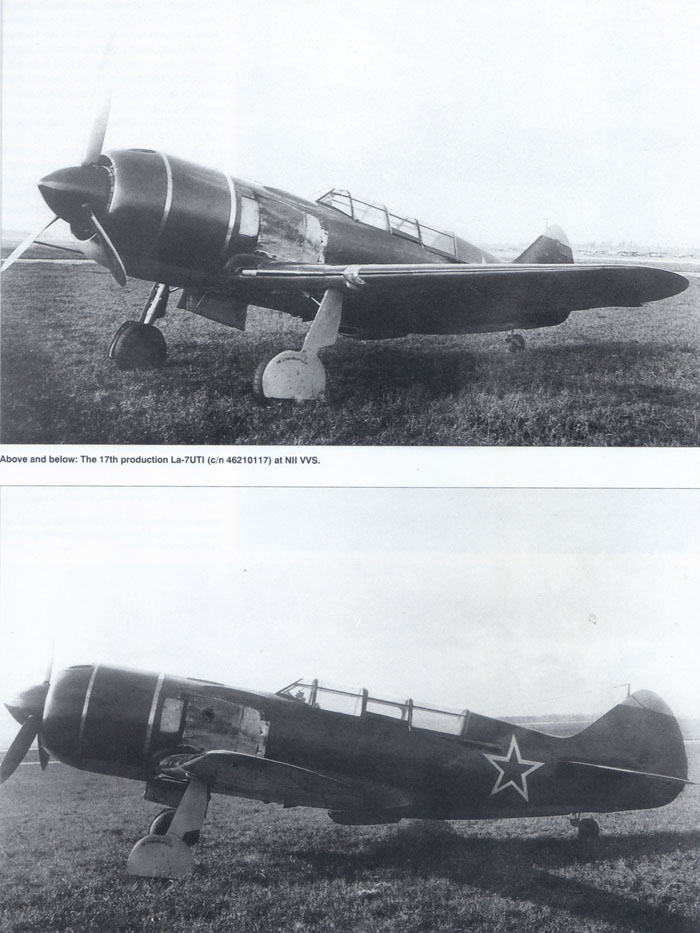
Later, the La-7UTI was identified as 'type 46' (being the La-7 the 'type 45').
In October 1945, a new La-7UTI s/n 46210117 (according to the code, seems the 17th plane of the serie 01) was sent to the NII VVS for new tests. It was counterweighted with two iron bars under the nose cowling, for a total of 25 kg, moving the CG of 1,5%. Besides, the insulation and ventilation of the cockpit were improved, slightly improving the control of temperature.
The aircraft was equipped with a radio RSI-4, landing lamp, a cover in the cockpit of the cadet for the blind flight, and a brake control system copied from Yak-9. It was possible to install a radio compass RPKO-10M, camera AFA-IM, foto gun PAC-22, and the artificial horizon indicator rate.
The aircraft was tested between 6 to 19 October. Despite the manoeuvrability comparable to that of standard La-7 and the improved landing characteristics, the plane didn't pass the tests because of the high temperature into the cockpit and other problems.
Here are two photos of the La-7UTI s/n 46210117.
Compared to the previous prototype, we see:
-
This plane differs visibly from the previous one because of the presence of the radio equipment (RSI-4 receiver only); the wire aerial goes to a short mast, nearly horizontal, on the right side of the fuselage:
-
the tail wheel wasn't retractable.There are no doors for the tail wheel, and the vane was made narrower and a bit shorter than on standard La-7s;
-
the landing light is clearly visible on the leading edge of the left wing;
- it seems to be a plate over the nose on the center line; probably it's related to the presence of a counterweight;
- there seem to be a fixed venting intake in front of the windshield, on the right side (see photos below, from inside of the cockpit) and a movable venting intake on the lower part of the fuselage, in front of the cooler;
-
the plane looks painted in the postwar livery with green AGT-4 on uppersurfaces and light gloss blue AGT-7 on the undersurfaces;
-
the stars are visible on the fuselage sides and on the wing undersurfaces, but not on the tail; it's unclear if there were stars on the upper wing surfaces, but it's very likely; note the white cap on the fin and rudder.
In April 1946, plane s/n 46210117 was presented again to NII VVS. This time it was equipped with spring balancers on the elevators to help to control of the aircraft during landings, but its too moved back CG created an unsufficient stability.
(photos from Red Stars 10 - Lavochkin piston-engined fighters, Y.Gordon)

Some images of the cockpits of 46210117:
-
top left, front cockpit, provided with a curtain on the windshield's frame; an air intake is visible outside, on the right side between the windshield and the opened nose panels;
-
top right, the instructor's cockpit;
-
bottom left, the left side of the front cockpit;
-
bottom right, the right side of the front cockpit.
Images from Aviakollectia 11/2009

In January 1946, plane s/n 46210325 was presented to the NII VVS, but it was rejected due to the CG still too back and to the unsafe position of balance weights on the gearbox.
Here we see the La-7UTI s/n 46210325 during NII VVS tests.
This plane differs visibly from the previous one because of the presence of the full radio equipment, visible under the glazing
(photos from Red Stars 10 - Lavochkin piston-engined fighters, Y.Gordon)
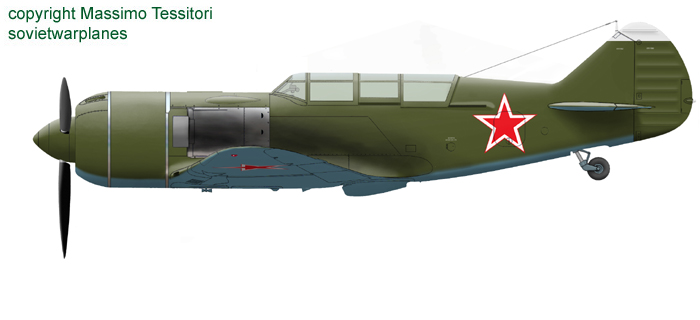
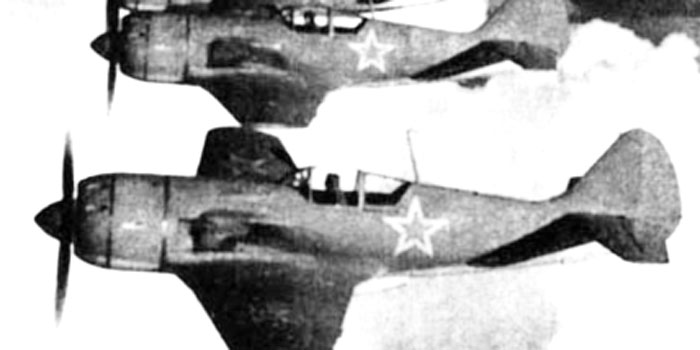
La-9 inflight, just to show the marks.
We see stars on the fuselages and not on the tails, just as La-7UTI.
Note that, although the light conditions are strange, these planes have national marks visible on the wings uppersurfaces.
After the war, there were some years of confusion about the number and position of the national marks on planes.
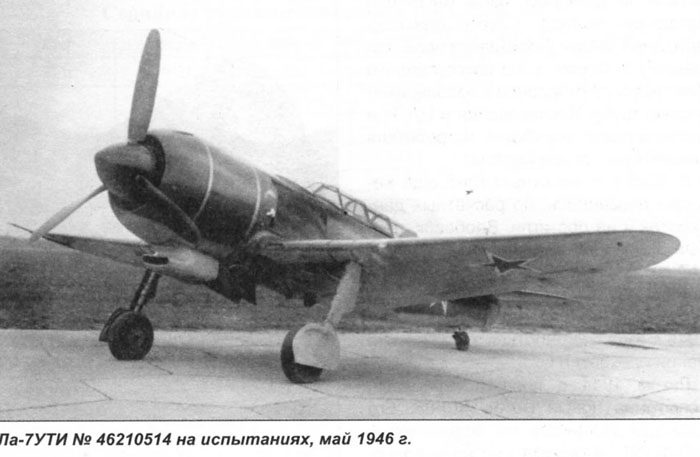
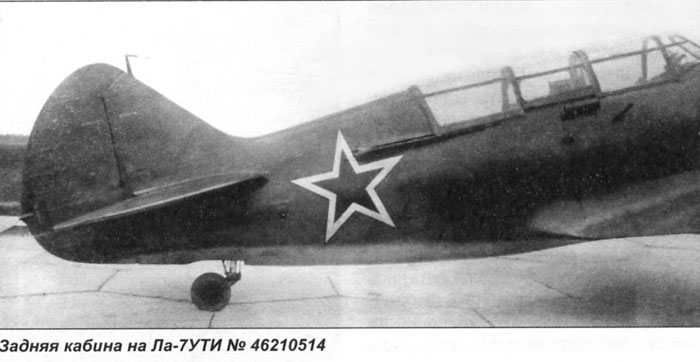
La-7UTI n.46210514 in May 1946.
La 7UTI s/n 46210514 was completed in May 1946. Its oil cooler was moved forward, under the second row of cylinders of the engine, and the counterweights were removed. The aircraft became lighter by 111 kg.
The machine was factory tested from 16 June to 16 August 1946, after which the aircraft was transferred to the Air Force Institute.
The behavior of the aircraft remained similar to standard La-7s.
The plane has still some defects, but they were minor compared to the previous prototypes. After removing most of the defects, La-7UTI started to arrive to the units.
The oil cooler was moved under the engine cowling; its shape resembles to that of La-9UTI.
The Venturi probe was moved from its original position, between the wheels doors, and placed on the right side of the fuselage, close to the mast, as well visible on the photo below. This was done, probably, only on planes with the coolers under the engine cowling. It's likely that earlier planes with the cooler under the canopy preserved the original position of the Venturi.
The photo below, of the right side of the fuselage, shows clearly the position of the aerial mast (nearly horizontal, just under the rear frame of the pilot's sliding hood); there is also a smaller thing behind it that could be an insulator to make the wire enter into the fuselage up to the radio equipment, well visible under the glazing. Probably this mast was identical to that of earlier planes with the cooler under the cockpit.
Images from Aviakollectia 11/2009
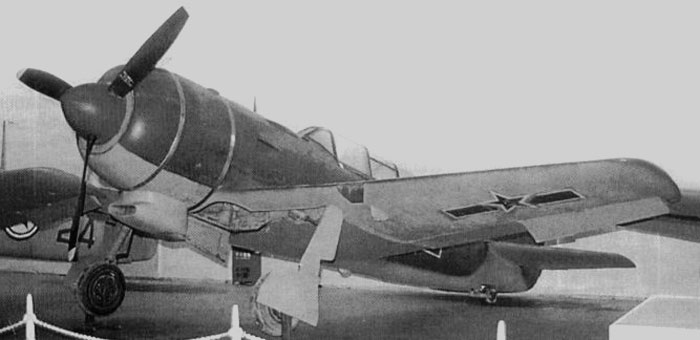
A Chinese La-9UTI in museum. Although being a different type of aircraft, note that the cooler appears similar to that of s/n 46210514 from this perspective.
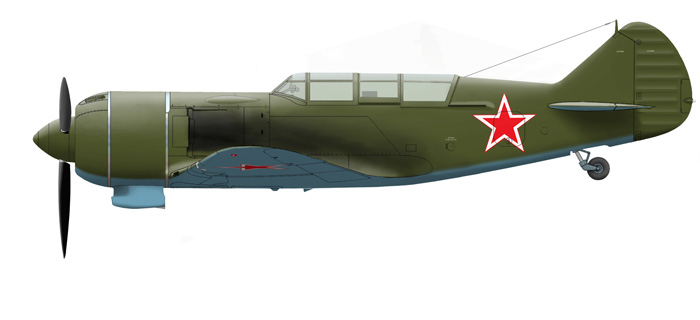
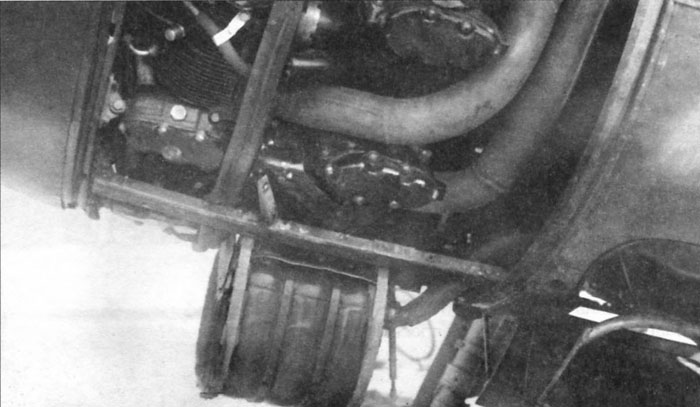
A detail of the uncovered cooler under the nose (probably) of s/n 46210514.
Images from Aviakollectia 11/2009
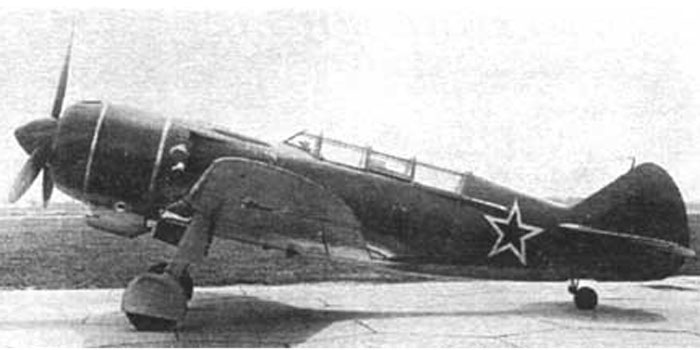
A La-7 UTI . This plane seems not the same of n.46210514 because, although the front of the oil cooler looks the same, the rear part looks different, having an oblique cut and a step. It's unclear which style characterized the most part of production planes.
The image is unclear, but this plane seems to have some painting on its tail and yellow tips of the propeller's blades.
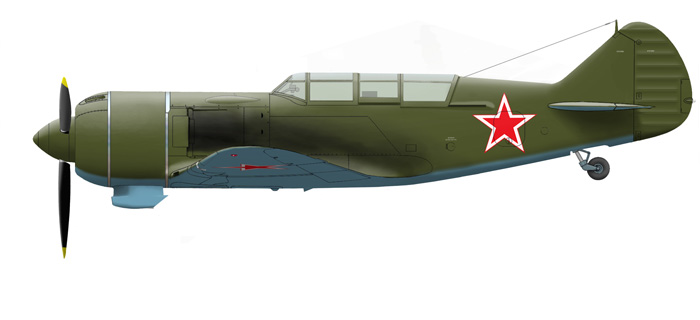

Images from Aviakollectia 11/2009.
The production plane is represented with a La-5 style cooler, more or less as the plane of the photo below.
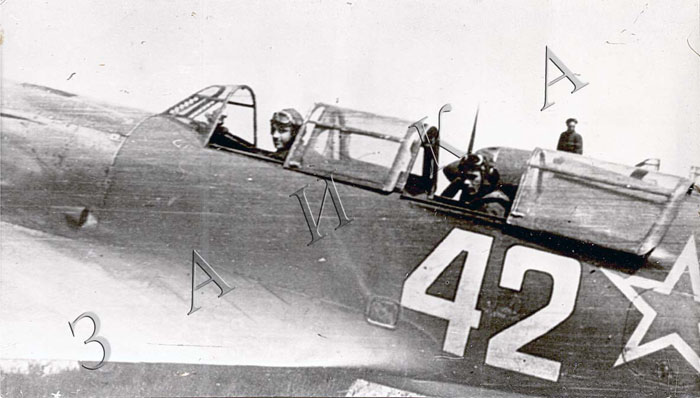
Rare photo of an operative La-7UTI n.42, with green and light blue livery.
The plane on the background seems a 3-guns singleseater La-7.
Image: Arch. Zaika

This La-7UTI had a cooler under the nose very similar to that of La-5s; it looks even a cooler of La-5, adapted by adding a sort of triangular sheet fairing on each side to improve the fitting of the outlet.
Both the photo caption (on MBI on Lavochkin La-7 of MilosVestsik), both the small profile on Aviakollectsia suggest that this type was the standard production plane, but the solution looks rougher than that seen on plane 46210514, that was similar to that of La-9UTI.
One could hypothize that this plane was obtained by conversion of a production La-7 into a trainer.
The total number of La-7UTI produced is not clear. According to Yefim Gordon, it reached 584 planes. According to MilosVestsik, 'was produced only in small quantities'.
I suppose the number of 584 planes could have been hypothized by the author on the base of some code '46210584' of the last produced plane, where :
'46' is for 'La-7UTI', '21' is for 'Zavod 21', '05' is for 'series 5 (supposedly of 100 planes each) and '84' for '84th plane of this series'.
But if plane n. 46210514 was the first considered 'nearly satisfactory' by the NII VVS, it's difficult to believe that series 01, 02, 03, 04 were produced in 100 planes each.
As a guess, I think that the 84 planes of series 5 were the only serially produced, plus one prototype only for each of series 1,2,3,4.
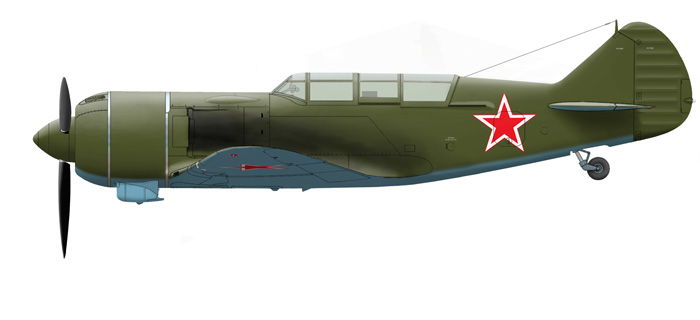

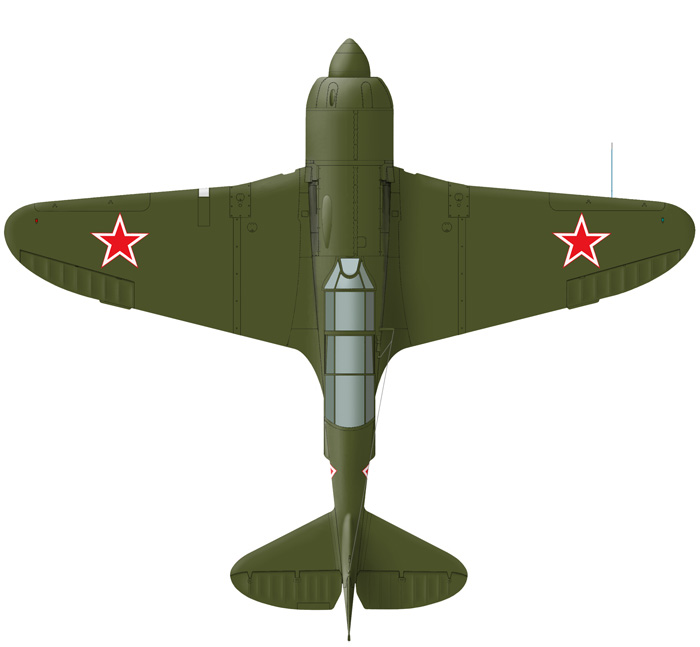
A reconstruction of the look of this plane with oil cooler similar to that of La-5.
The profile from the right shows the aerial mast on this side, as well as the Venturi probe that was relocated after the move of the cooler under the nose. The presence of a vent in front of the windshield on production planes is uncertain, and it was omitted.
The upper view shows national marks over the wings, similarly to La-9s.